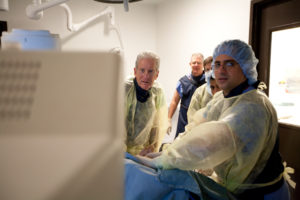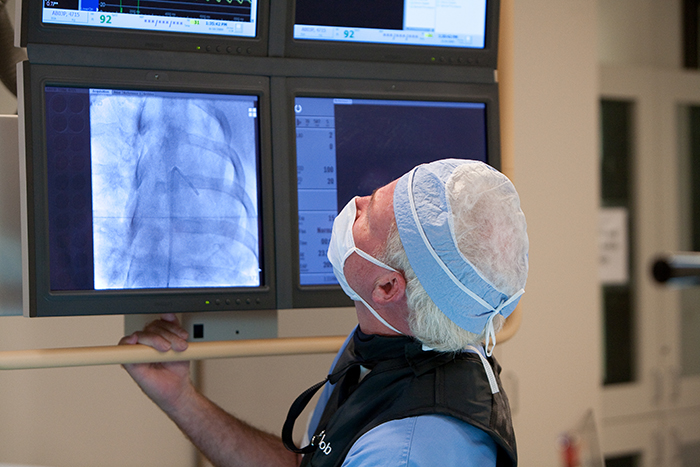In the context of GCMI’s phase-gated product development, the “Design and Development” phase (also called “Phase 2” at GCMI) typically follows a Project Planning phase (called “Phase 1” at GCMI). At the completion of project planning, innovators have determined what work is required to take the technology from prototype to product. The Design and Development phase is all about the meat of the design work: digging in to complete the design tasks, and ensuring that the device is ready for manufacturing and customer use.
The ultimate milestone of the design and development process is called “design freeze.” At the exit of Phase 2, a device should include all of the features required for function and safety, and the project team should have confidence that the device will meet all of the input requirements. The marketing team should also approve the look and feel of the device for the intended customers.
Where do preclinical activities find their way into design and development?
Design input requirements & confirmation
According to the FDA (federal code 21 CFR 820), “Design inputs are the physical and performance characteristics of a device that are used as a basis for device design.” The project team must “ensure requirements are appropriate by addressing user needs and intended use(s) in terms that are measurable.”
Design inputs should be identified during Phase 1, but may be refined and values confirmed during Phase 2. These inputs are the engineering requirements necessary for the product to meet the User Needs, and they might be determined based on device(s) currently on the market as a benchmark. For example:
- User Need: Device must facilitate the user to deliver medication into patient veins
- Design Input Requirement: Fluid flow rate through the device shall be no less than 5 milliliters per minute.
GCMI Director of Product Development Mike Fisher tells us, “User needs are broad and must be validated. Design inputs are specific and are typically verified.
 User needs articulate the reason why a medical device exists. Typically, user needs speak to the “indications for use” which often include treating a disease state and a patient. Sometimes, user needs will impose additional requirements like “enable minimally invasive procedures” or “reduce exposure to radiation.” User needs must be validated at the end of the development process where a clinician will be asked “Does this device enable use of minimally invasive techniques / reduce exposure to radiation / etc.?” Validation questions are summative evaluations if the device meets the user needs and expectations.
User needs articulate the reason why a medical device exists. Typically, user needs speak to the “indications for use” which often include treating a disease state and a patient. Sometimes, user needs will impose additional requirements like “enable minimally invasive procedures” or “reduce exposure to radiation.” User needs must be validated at the end of the development process where a clinician will be asked “Does this device enable use of minimally invasive techniques / reduce exposure to radiation / etc.?” Validation questions are summative evaluations if the device meets the user needs and expectations.
Design inputs, on the other hand, are specific requirements that enable the user needs. For example, if a user need is stated as “meet or exceed the mechanical performance of a predicate facet screw,” the specific input requirements will be meeting or exceeding bench top testing for predicate screws (ASTM F1978 testing). If a user need is stated as a sterile device, the design input “complies with ISO 1137 radiation sterilization” (which is a consensus standard).
“Design input identification is one thing,” says GCMI Preclinical Program Director Evan Goldberg says. “Mitigating and solving for those risks occurs more rigorously in verification and validation testing when the idea is closer to its final form, if not at ‘design freeze.’
“Preclinical testing in the earlier ‘design and development phase’ intends to see if it works before you get controls around it when bench testing just won’t accomplish the task. These tests, cadaveric or in vivo, would be defined as ‘proof of concept.’ Preclinical testing at this stage doesn’t have ‘guardrails’ on it.”
Put another way, this type of testing helps provide early validation of the user needs as well as confirmation of feasibility.
Let’s see if this works
“At the end of the day, some testing requirements in the design and development phase simply cannot be done ‘on the bench,’ Evan says. “In design input requirements and confirmation activities within the design and development phase, only cadaveric or small scale in-vivo testing can determine if a device provides appropriate grip or traction for the user, or if it works as intended in a beating heart or vessels with blood flow. This is important for example in interventional cardiology technologies like stents, guide wires and catheters.”
Preclinical’s role in risk assessment & mitigation
From our previously published design and development process article, “If design inputs are the ‘offensive side of product requirements, risk assessment plays the role of ‘defense.’
“The risk management process complies with international standards (ISO 14971) and aims to identify hazards associated with the device, describe and estimate the risks associated with the hazard, and control the risks as needed. The engineering team will delve into every detail of the product to bring to light as many risks as possible in the design and development phase.
- How might a customer mis-use the device? What clinically harmful outcomes might happen with each type of mis-use?
- Is any feature on the device too big, too small, too rough or too smooth to perform the intended functions every time?
- Is the device compatible with other standard instruments used in a surgical setting? For a newly developed orthopedic drill, does a standard surgical Torx driver fit, or does the device require a special bit?
- On a vascular graft, for example, is the connection method too stiff compared to the vein tissue? Will the device cause vessel tears leading to bleeding?”
“Determining worst case scenarios and their validity to inform design changes can only be fully satisfied in cadaveric or small scale in vivo testing for many devices and technologies,” Evan says. “Does the device cause collateral damage to adjacent organs or structures in the use environment for which it is intended? Is there potential for the device to fail or break when used as intended in that same environment?
“Again, those questions need to be answered in the design and development phase. They cannot be answered ‘on the bench,’ and must be answered prior to more rigorous verification and validation testing in which preclinical work plays a substantial role.”
Feasibility Testing
During Phase 2, bench top, preclinical, and usability testing gives the project team confidence that the product will meet the input requirements and be acceptable to the intended customers. The type of testing should be identified based on the question to be answered. For example:
A bench top test might answer: “Does this battery provide enough current to power the display screen?”
 According to Evan, a usability test might answer: ‘Can a user operate the handle on a cardiac catheter without difficulty?’ Again, you simply can’t determine this on the bench. One could simulate with water or other fluids, but that doesn’t adequately replicate the feeling or conditions with vessels and blood, which may clot.
According to Evan, a usability test might answer: ‘Can a user operate the handle on a cardiac catheter without difficulty?’ Again, you simply can’t determine this on the bench. One could simulate with water or other fluids, but that doesn’t adequately replicate the feeling or conditions with vessels and blood, which may clot.
A preclinical study for feasibility might also answer: ‘How well does this bone screw keep a plate secured to the tibia after 14 days?’
“Preclinical’s role in a new technology’s journey through the design and development phase is fully dependent on the product itself,” Evan says. “For orthopedic devices or technologies, titanium alloys have been very well tested and proven. But combining proven materials with a new or novel coating may easily create issues you may not have considered. In those cases, testing in a biological system in the design and development phase would be prudent, if not mandatory. The same goes for cardiovascular, urologic, gastrointestinal and other physiologic systems that rely upon interactions with other organs or work against fluids in the body.”
The result
By the exit of Phase 2, “design freeze,” the product should have its final design features, all specifications and manufacturing processes have been documented, and the project team is confident that the device can be a sellable product that can enter initial (pilot) manufacturing and pass its verification testing.
Test results then feed the design iteration cycle with insight into design inputs, a more complete picture of risks, and an understanding of device performance.
Why GCMI?
Our team plans for significant effort during the design and development phase because we know the hurdles involved in ensuring that the design meets the needs of its users. Clear requirements definition and risk mitigation, plus an emphasis on sufficient testing (including preclinical) during the design and development phase de-risks the process and product. GCMI serves as your comprehensive project planning, research and development team, taking an integrated view of product design and manufacturing process development. Our phased approach supported by our industry leading preclinical facility and team gives promising technologies the best chance to achieve commercialization in a cost efficient manner.
